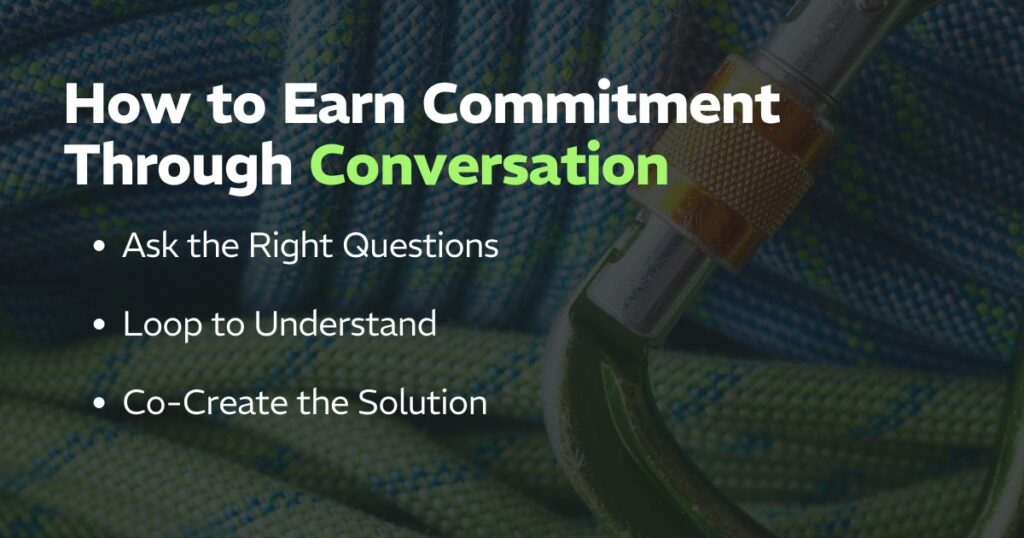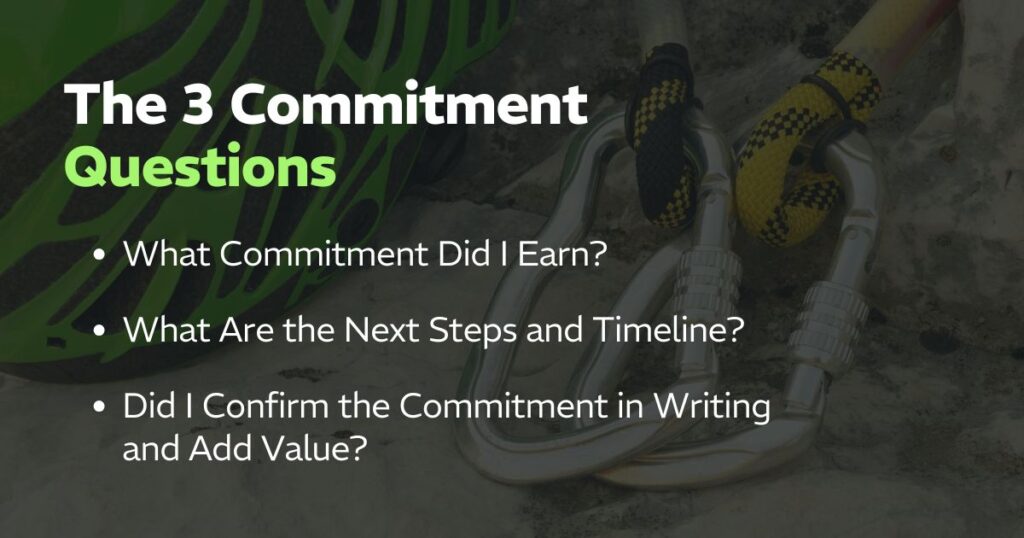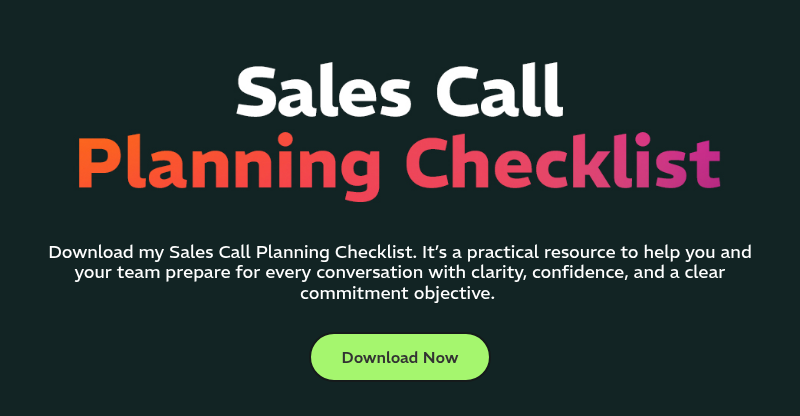“I’ll talk to my team.”
“Let’s reconnect in Q4.”
“Circle back in a few weeks.”
We’ve all heard those phrases. And if we’re honest, we’ve let them slide more often than we should.
Most deals don’t fall apart because of a flaw in the product or service. Ask any salesperson, and they’ll tell you they lose more deals to “no decision” than to the competition: One large-scale study of more than 2.5 million recorded sales conversations found that 40% to 60% of deals are lost to customers who express intent to buy but ultimately fail to act.
Our job as sales professionals is to overcome that indecision by securing a series of small, intentional commitments. We know that big deals rarely close in a single conversation. Progress is earned, step by step, at every touchpoint.
The Law of Incremental Commitment in Sales
Top-performing sales reps understand that success is a series of micro commitments in the sales cycle that advance the relationship. They don’t walk into a conversation hoping to get lucky. They walk in with a purpose.
Every sales activity requires a commitment objective. Before the meeting, ask yourself: What specific next step am I trying to earn? That clarity will shape how you show up, what you say, and how you present your perspective.
Whether you’re recommending a next meeting, scheduling a demo, or requesting stakeholder alignment, you’re always aiming for the next logical inflection point. Map your presentation and storytelling to that outcome.
Commitment is the bridge between value and momentum. And momentum is how you increase the likelihood of closing the deal.
Ask the Right Questions
Open ended questions draw out fear and resistance. They uncover pain points, reveal emotional triggers, and surface internal barriers to action. Top performers prepare thoughtful, open-ended questions that get customers talking.
If you’re doing most of the talking in a sales call, you’re likely missing the information that matters most. Your job is to create space for the customer to share what they want, what they fear, and what stands in their way. That clarity is your entry point to value.
Loop to Understand
Listening without validation is only half the equation. Listen to understand. Probe twice for context. Once you’ve heard your customer, loop back. Summarize for clarity and connection. Recap what they said in your own words and check for alignment: “What I’m hearing is…”
This technique helps confirm information, but it also helps build trust. When a customer feels understood, they feel safer taking the next step. And trust is the foundation of every micro commitment in the sales cycle.
Co-Create the Solution
You don’t need to pitch your way through objections if you learn to partner through them. Co-creating means walking alongside your buyer through their internal process, aligning with their team’s needs, and helping them confidently advocate for your solution to the decision maker.
Done well, co-creation also shortens the sales cycle. It builds consensus faster and gives buyers confidence that investing in your product or service is the right move. Whether you’re guiding them to a resource, recommending a demo, or offering a curated landing page, the message should always reinforce shared ownership of the outcome.
Too many sellers pitch prematurely. But real traction happens when the solution is built with the customer, not for them. That means linking your recommendation directly to their words: “Because you said X, I would recommend Y.”
This approach shifts the dynamic. You’re no longer just presenting options. You’re partnering. You’re aligning to their priorities, speaking their language, and guiding them toward the commitment that makes sense for them.
Every interaction is an opportunity to earn trust and action. If you want to gain commitment in sales, you need to show up ready to listen, understand, and co-create the path forward.

The 3 Commitment Questions
These questions can help great sales leaders coach their teams and how elite sales reps stay accountable to results. Use them to assess where a deal truly stands in your sales funnel, and to identify what step you can influence next.
Over time, this level of rigor creates consistency. It forces you to invest time where it counts, rather than chasing conversations that sound good but don’t convert. It also sharpens your awareness of which deals are stalling and which ones are on track to close the sale.
Even the most dynamic sales conversations fall flat without follow-through. That’s why commitment can’t be an afterthought. It has to be a built-in part of your sales process.
After every customer engagement, take a moment to evaluate progress. Don’t rely on gut instinct or good feelings. Rely on clarity.
Use these three questions as your post-call checklist. They help you spot momentum—or the lack of it—before it’s too late.
What Commitment Did I Earn?
Be honest. Did the customer agree to do something specific? A follow-up meeting, a product trial, an internal conversation with a decision maker?
If there’s no commitment, there’s no movement. Vague interest doesn’t count. The best sales professionals are relentless about clarity: Did the buyer take a step forward?
What Are the Next Steps and Timeline?
A commitment without a timeline is a wish. Ask for clarity and define what’s happening next and when. Whether it’s a next meeting, review cycle, or internal approval process, you need to walk away with concrete next steps anchored in time.
This helps keep the deal alive while also setting expectations and preventing things from slipping into the “someday” zone.
Did I Confirm the Commitment in Writing and Add Value?
Verbal agreements fade. Follow up in writing to document the commitment and provide additional value. It might be a helpful resource, a personalized insight, a recap of their pain points, or a landing page with tailored content.
This demonstrates professionalism, reinforces trust, and keeps the momentum moving forward.
If you can’t clearly answer all three, the deal is at risk. These questions help you assess momentum, avoid stalls, and stay focused on qualified opportunities.
If you want to gain commitment in sales consistently, these three questions should live at the center of your sales process.

Storytelling + Value = Permission to Challenge
Today’s customers expect more than service—they expect insight. To create value, we sometimes need to challenge assumptions, introduce new thinking, or reframe priorities.
That’s easier to do when we lead with empathy and deliver our perspective through storytelling. When customers feel understood and see their story reflected back with clarity, they’re more open to action.
Gaining commitment in sales is easier when the customer sees your intent as adding value. This is how you increase the likelihood of closing the deal, building long term trust, and creating referrals.
Commitment isn’t pressure. It’s partnership.
Close Strong: The Commitment Challenge
Before your next sales call, define your commitment objective. After the call, take time to reflect and answer the three commitment questions with clarity and intention.
If any of those answers are unclear, the deal isn’t progressing—it’s stalling.
Don’t settle for interest.
Earn the commitment.
Ready to Take Your Team’s Performance to the Next Level?
If this message resonated, and you’re looking to help your team sell with more purpose, presence, and impact—I talk about this in depth in my keynote, Sell for Impact. It’s designed for sales kickoffs and leadership meetings, and it’s all about helping sellers earn trust, create value, and move deals forward with confidence.











